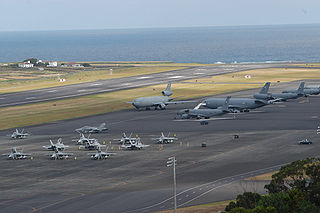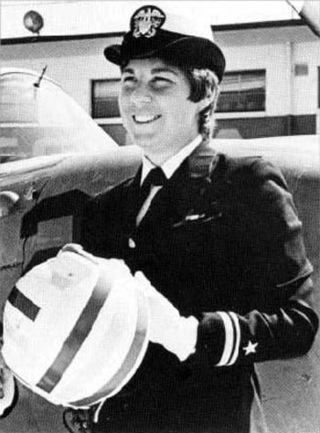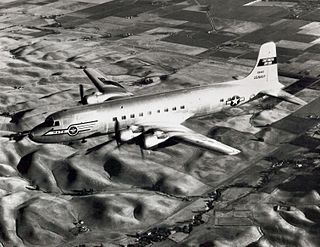
The McDonnell FH Phantom is a twinjet, straight-wing, carrier-based fighter aircraft designed and first flown during late World War II for the United States Navy. As a first-generation jet fighter, the Phantom was the first purely jet-powered aircraft to land on an American aircraft carrier and the first jet deployed by the United States Marine Corps. Although only 62 FH-1s were built it helped prove the viability of carrier-based jet fighters. As McDonnell's first successful fighter, it led to the development of the follow-on F2H Banshee, which was one of the two most important naval jet fighters of the Korean War; combined, the two established McDonnell as an important supplier of navy aircraft.

Hickam Air Force Base is a United States Air Force (USAF) installation, named in honor of aviation pioneer Lieutenant Colonel Horace Meek Hickam. The installation merged in 2010 with Naval Station Pearl Harbor to become part of the newly formed Joint Base Pearl Harbor–Hickam, on the island of Oʻahu in the State of Hawaiʻi. The base neighbors Daniel K. Inouye International Airport and currently shares runways with the airport for its activities and operations.

The Douglas C-54 Skymaster is a four-engined transport aircraft used by the United States Army Air Forces in World War II and the Korean War. Like the Douglas C-47 Skytrain derived from the DC-3, the C-54 Skymaster was derived from a civilian airliner, the Douglas DC-4. Besides transport of cargo, the C-54 also carried presidents, prime ministers, and military staff. Dozens of variants of the C-54 were employed in a wide variety of non-combat roles such as air-sea rescue, scientific and military research, and missile tracking and recovery. During the Berlin Airlift it hauled coal and food supplies to West Berlin. After the Korean War it continued to be used for military and civilian uses by more than 30 countries. It was one of the first aircraft to carry the President of the United States, the first being President Franklin D. Roosevelt during World War II.

The Douglas DC-6 is a piston-powered airliner and cargo aircraft built by the Douglas Aircraft Company from 1946 to 1958. Originally intended as a military transport near the end of World War II, Douglas reworked it after the war to compete with the Lockheed Constellation in the long-range commercial transport market. Douglas built over 700, and many still fly in cargo, military, and wildfire control roles.
This is a list of aviation-related events from 1950:
This is a list of aviation-related events from 1951:
This is a list of aviation-related events from 1952:
This is a list of aviation-related events from 1953:
This is a list of aviation-related events from 1955.
This is a list of aviation-related events from 1956.

Lajes Field or Lajes Air Base, officially designated Air Base No. 4, is a multi-use airfield near Lajes and 15 km (9.3 mi) northeast of Angra do Heroísmo on Terceira Island in the Azores, Portugal. It is home to the Portuguese Air Force Base Aérea N º4 and Azores Air Zone Command, a United States Air Force detachment unit, and a regional air passenger terminal. Located about 3,680 km (2,290 mi) east of New York City and about 1,600 km (990 mi) west of Lisbon, Portugal; the base sits in a strategic location midway between North America and Europe in the north Atlantic Ocean.

United Air Lines Flight 409 was a scheduled flight which originated in New York City, New York. The final flight destination was San Francisco, California, with stops in Chicago, Denver and Salt Lake City. The aircraft operating the service, a Douglas DC-4 propliner, registration N30062, crashed into Medicine Bow Peak, near Laramie, Wyoming, on October 6, 1955, killing all 66 people on board. The victims included five female members of the Mormon Tabernacle Choir and military personnel. At the time, this was the deadliest airline crash in the history of American commercial aviation. Another 66 lives had been lost earlier that year in the March 22 crash in Hawaii of a United States Navy Douglas R6D-1 Liftmaster military transport aircraft, and 66 had also died in the mid-air collision of two United States Air Force C-119G Flying Boxcars over West Germany on August 11, placing the three crashes in a three-way tie as the deadliest aviation incidents in 1955.

The 305th Air Mobility Wing is a United States Air Force strategic airlift and air refueling wing under the operational control of the Air Mobility Command. It generates, mobilizes and deploys C-17 Globemaster III and KC-46A Pegasus aircraft. The 305th AMW is a tenant unit at mostly the McGuire AFB component of Joint Base McGuire-Dix-Lakehurst in central New Jersey. It also controls one of the Air Force's busiest aerial ports, and the air operations at both McGuire Air Force Base and Naval Support Activity Lakehurst.

The Military Air Transport Service (MATS) is an inactive Department of Defense Unified Command. Activated on 1 June 1948, MATS was a consolidation of the United States Navy's Naval Air Transport Service (NATS) and the United States Air Force's Air Transport Command (ATC) into a single joint command. It was inactivated and discontinued on 8 January 1966, superseded by the Air Force's Military Airlift Command (MAC) as a separate strategic airlift command, and it returned shore-based Navy cargo aircraft to Navy control as operational support airlift (OSA) aircraft.

Naval Air Station Sanford was a naval air station of the United States Navy in Sanford, Florida, approximately 20 miles north of Orlando, Florida. Opening less than a year after the start of World War II, NAS Sanford's initial function was as an advanced training base for land-based patrol bombers, followed by carrier-based fighter aircraft. The air station briefly closed in 1946 and was placed in caretaker status until being reactivated in 1950. It eventually served as a Master Jet Base for carrier-based heavy attack and reconnaissance aircraft until 1969. After its closure, it reopened as civilian general aviation airport under various names with a non-Navy civilian airport identifier until finally transitioning to a scheduled air carrier airport under its current name of Orlando-Sanford International Airport.

Barbara Ann Allen Rainey was one of the first six female pilots in the U.S. armed forces. Rainey received her wings of gold as the first female to be designated a naval aviator in February 1974 and became the first Navy woman to qualify as a jet pilot. She attained the rank of Lieutenant Commander in the United States Navy. She was killed in an aircraft crash in 1982 while performing her duties as a flight instructor.

The 1960 Rio de Janeiro mid-air collision was an aerial collision between two aircraft over Rio de Janeiro, Brazil on February 25, 1960. A United States Navy Douglas R6D-1 (DC-6A) flying from Buenos Aires-Ezeiza to Rio de Janeiro-Galeão Air Force Base collided over Guanabara Bay, close to the Sugarloaf Mountain, with a Real Transportes Aéreos Douglas DC-3, registration PP-AXD, operating flight 751 from Campos dos Goytacazes to Rio de Janeiro-Santos Dumont Airport. The crash occurred at 16:10 local time at an altitude of 1,600 meters.

The crash of Canadian Pacific Air Lines Flight 3505 occurred on 21 July 1951 when a Douglas DC-4 four-engined piston airliner registered CF-CPC of Canadian Pacific Air Lines disappeared on a scheduled flight for the United Nations from Vancouver, Canada, to Tokyo, Japan. Neither the aircraft nor the 31 passengers and six crew have been found. The incident marked the first aircraft loss during the Korean Airlift.

The 1955 Hawaii R6D-1 crash was an accident involving a Douglas R6D-1 Liftmaster of the United States Navy which crashed into a mountain peak in Hawaii on 22 March 1955, killing all 66 people on board. At the time, it was the worst crash involving any variant of the Douglas DC-6 airliner the second-worst aviation accident in U.S. history, and one of the worst air accidents anywhere in history, and it equaled the 11 August mid-air collision of two United States Air Force C-119G Flying Boxcars over West Germany and the 6 October United Air Lines Flight 409 crash as the deadliest air accident of 1955. It remains the worst air disaster in the history of Hawaii and the deadliest accident involving a heavier-than-air aircraft in the history of United States naval aviation.













